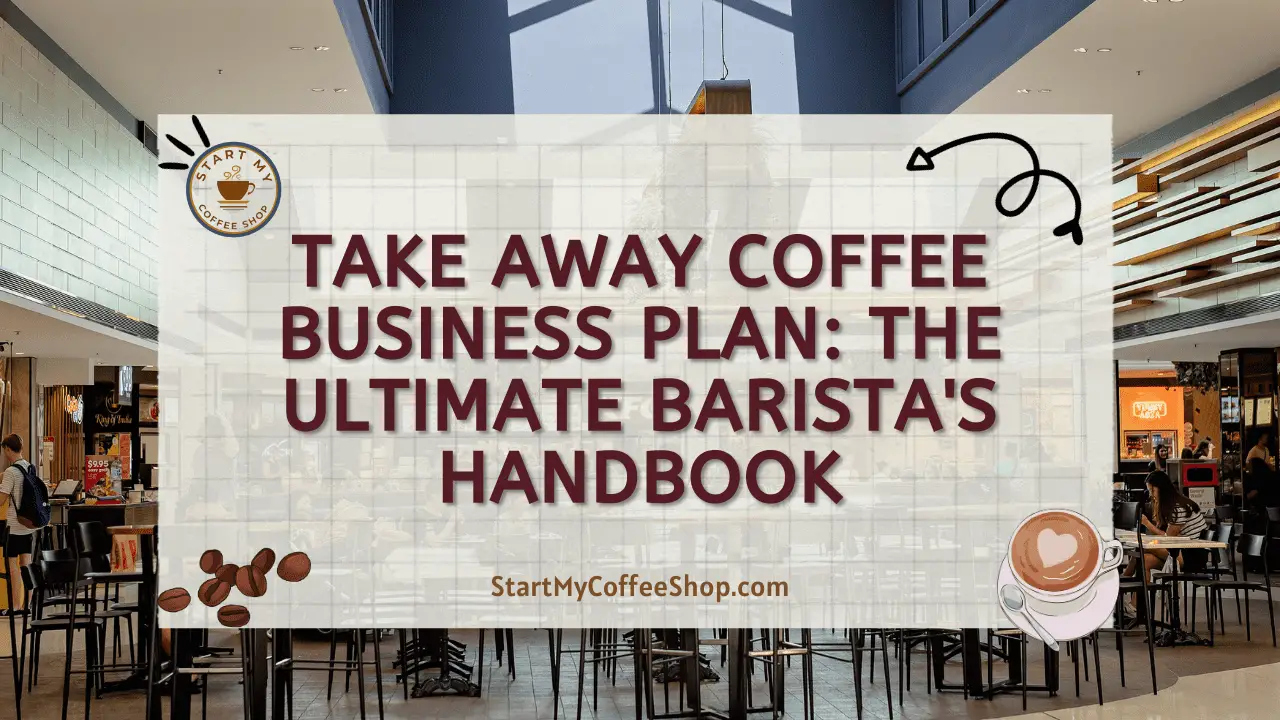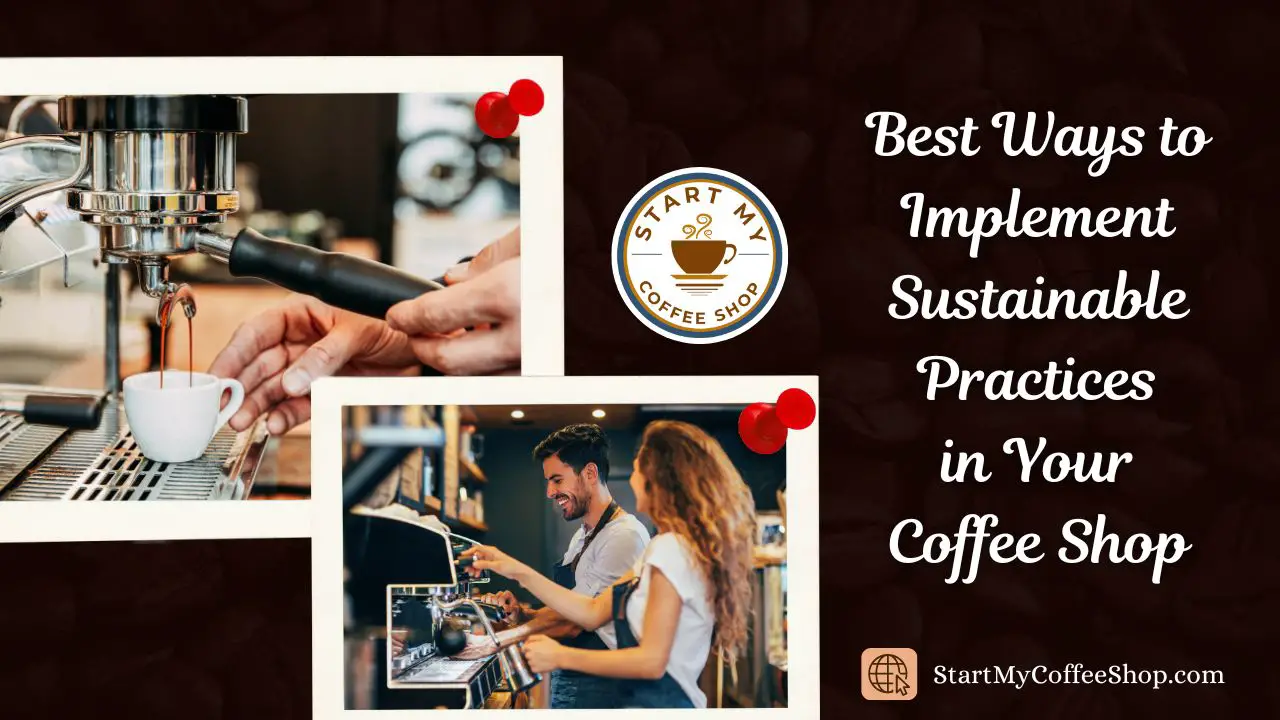In today’s fast-paced world, where time is of the essence, the demand for convenient and quality takeaway coffee has soared. Capitalizing on this trend, starting a takeaway coffee business can be a great venture. However, a well-crafted business plan is essential to navigate the competitive landscape and ensure long-term growth.
A comprehensive takeaway coffee business plan covers market analysis, differentiation, menu offerings, operations, staffing, marketing, pricing, financial projections, and future growth strategies. Craft your path to winning the hearts of coffee lovers in the booming world of takeaway coffee!
In this article, I will outline a comprehensive business plan for a takeaway coffee business.
Executive Summary
First and foremost, the executive summary introduces your business concept. It succinctly describes the nature of your takeaway coffee business, emphasizing its unique selling points and the value it brings to customers. Whether it’s the specialty coffee blends, personalized customer service, or innovative menu offerings, highlight what sets your business apart from the competition.
Next, outline your target market. Identify the specific demographic, psychographic, and geographic characteristics of your ideal customers. Discuss their preferences, and needs, and how your business is positioned to cater to them effectively. Highlight any market trends or shifts that present growth opportunities.
Furthermore, emphasize your competitive advantage. Clearly articulate what gives your takeaway coffee business an edge over others in the market. This could be your prime location, superior product quality, sustainable sourcing practices, or a unique brand identity. Showcase why customers should choose your coffee over alternatives.
Finally, provide a glimpse into your financial projections. Summarize the anticipated revenue and profit margins based on thorough market research and realistic assumptions. Address the initial investment required and the expected return on investment. This will demonstrate the financial viability and potential growth prospects of your business.
Remember, the executive summary should be engaging, compelling, and concise. It should pique the interest of readers, encouraging them to delve deeper into your business plan.
Read more about: Cost to Open a Coffee Cart: Calculating the Cost of Entry
Market Analysis
To establish your takeaway coffee business, it is essential to embark on comprehensive research of the local coffee market. This research entails a meticulous examination of various factors that shape the industry landscape.
Begin by analyzing consumer preferences within the market. Understand the evolving tastes, trends, and demands of coffee enthusiasts in your area. Explore the diverse range of coffee options favored by local consumers, such as specialty brews, flavored coffees, or alternative milk choices. By staying attuned to these preferences, you can tailor your offerings to cater precisely to the desires of your target audience.
Demographic analysis is another crucial aspect of market understanding. Investigate the demographic makeup of your target area, including age groups, income levels, and lifestyles. This knowledge will help you determine the most viable customer segments to focus on and design strategies to effectively reach and engage them.
Furthermore, a thorough examination of the competition is vital. Identify existing coffee shops, cafes, and other establishments offering takeaway coffee in your vicinity. Study their strengths, weaknesses, and unique selling points. This analysis will enable you to identify gaps or opportunities in the market that your business can exploit, setting itself apart from competitors.
Once armed with this market intelligence, you can identify your specific target audience and their unmet needs. Determine how your takeaway coffee business can fulfill those needs better than your competitors.
This might involve offering premium quality coffee beans sourced from specific regions, providing exceptional customer service, or creating an inviting ambiance that fosters community engagement. Aligning your business to address these unmet needs will enhance your competitive advantage and resonate with your target audience.
You lay a solid foundation for your takeaway coffee business by conducting thorough market research and analyzing consumer preferences, demographics, competition, and trends. This understanding enables you to position your business strategically, differentiate yourself from competitors, and tailor your offerings to meet the specific needs and desires of your target audience.
Business Concept and Differentiation

Defining your business concept and establishing a strong unique selling proposition (USP) is crucial to set your takeaway coffee business apart from the competition. Start by identifying the key factors that differentiate your business and make it unique.
Consider the quality of your coffee beans as a potential USP. Are you sourcing beans from specific regions known for their exceptional flavor profiles or using specialty blends that are distinct and hard to find elsewhere? Highlight the superior quality of your coffee and emphasize how it creates a memorable and satisfying experience for your customers.
Another potential USP is personalized service. Will you offer a customized approach, such as allowing customers to choose their preferred brewing method, grind size, or flavor enhancements? Highlight how your knowledgeable and friendly staff will go the extra mile to ensure each customer’s coffee preferences are met, fostering a personalized and memorable experience.
The ambiance of your store can also be a unique selling proposition. Will you create a cozy, inviting atmosphere with comfortable seating and aesthetically pleasing decor? Will you provide a space that promotes socializing, relaxation, or productivity? Clearly articulate how your store’s ambiance will enhance the overall coffee-drinking experience, enticing customers to return and spend more time in your establishment.
When articulating your USP, ensure it resonates with your target audience. Understand their needs and desires, and convey how your unique offering meets those requirements better than competitors. Emphasize the benefits customers will gain from choosing your takeaway coffee business over others.
To attract and retain customers, consistently deliver on your USP promise. Train your staff to uphold the standards of quality, service, and ambiance you’ve set. Continuously seek feedback from customers to gauge their satisfaction and make necessary improvements. Create a sense of loyalty and connection by engaging with your customers through loyalty programs, personalized promotions, or social media interactions.
Menu and Product Offering
Start by understanding the tastes and preferences of your customers, ensuring that your menu aligns with their desires.
Offer a diverse range of coffee options to appeal to different preferences. Include specialty brews such as pour-over, cold brew, or espresso-based drinks. Highlight unique flavor profiles and brewing techniques that showcase your expertise and set your offerings apart from standard coffee chains.
Additionally, consider offering flavored coffees that add a touch of variety and excitement to your menu. Incorporate alternative milk options to cater to customers with dietary restrictions or personal preferences. Include choices like almond milk, soy milk, oat milk, or coconut milk.
To complement your coffee offerings, consider including snacks, pastries, or light meals. These options can range from freshly baked goods like croissants, muffins, and cookies to savory items such as sandwiches, wraps, or salads. Make sure to select high-quality ingredients and prioritize freshness to elevate the overall dining experience for your customers.
Keep in mind the balance between variety and managing your inventory efficiently. Conduct market research and gather customer feedback to identify the most popular menu items and refine your offerings accordingly. Regularly update your menu to incorporate seasonal specials or limited-time promotions, keeping customers excited and encouraging them to explore different options.
Present your menu in an aesthetically pleasing and informative manner. Use visually appealing descriptions, enticing imagery, and clear categorization to facilitate customer decision-making. Consider offering different sizes or customization options to accommodate individual preferences.
Continuously assess the performance of your menu items, tracking sales data and customer feedback. This information will help you identify popular choices and refine your offerings over time. Regularly introduce new items or rotate existing ones to keep your menu fresh and exciting.
Read more about: Cost to Open a Coffee Bar: A Cappuccino Economics
Operations and Equipment
When planning the logistics of your takeaway coffee business, attention to detail is crucial. Begin by envisioning the physical layout of your store, carefully considering the flow of operations and customer experience.
Determine the optimal seating arrangements based on the available space and the desired ambiance. Will you provide comfortable seating options for customers who wish to enjoy their coffee in-store? Consider the layout of tables, chairs, and any additional furnishings that will enhance the overall atmosphere and accommodate the anticipated number of customers.
Allocate sufficient counter space to facilitate smooth and efficient customer service. This area will serve as the primary point of interaction between your baristas and customers. Ensure it is well-organized, with designated areas for order taking, coffee preparation, and payment processing. Consider incorporating display areas to showcase your coffee offerings or any additional products you may sell.
Storage areas are essential for maintaining inventory and supplies. Assess your storage needs for coffee beans, milk, syrups, pastries, and other ingredients. Create an organized system that allows for easy access and proper rotation of items. Adhere to food safety regulations and ensure that storage areas are clean, well-maintained, and appropriately temperature-controlled.
Identify the necessary equipment required to operate your takeaway coffee business smoothly. This typically includes coffee machines, grinders, blenders, refrigeration units, and POS systems. Research reputable suppliers and select equipment that aligns with your business needs, budget, and quality standards. Regularly maintain and service your equipment to ensure consistent performance and longevity.
Compliance with health and safety regulations is paramount. Familiarize yourself with local health codes, licensing requirements, and food handling practices. Implement proper sanitation measures, train your staff on food safety protocols, and regularly conduct inspections to maintain a clean and safe environment for both employees and customers.
Consider the layout and logistics of your back-of-house operations as well. Designate areas for coffee bean storage, equipment maintenance, and staff facilities. Optimize the workflow to ensure efficient processes and minimize bottlenecks during peak hours.
Staffing and Training
Start by identifying key roles within your staff, such as baristas, cashiers, and store managers. Clearly outline their specific responsibilities and expectations. Baristas should be trained to expertly craft each cup of coffee, ensuring consistency and excellence in every brew.
Cashiers should handle transactions efficiently and provide friendly and helpful service to customers. Store managers should oversee operations, manage inventory, and ensure a seamless workflow.
Customer engagement is paramount in building loyalty and satisfaction. Train your staff to provide personalized service, engage in friendly conversations, and actively listen to customer preferences.
Encourage them to go beyond taking orders by offering recommendations, explaining different coffee options, and answering any questions customers may have. Developing a rapport with customers and creating a welcoming environment will leave a lasting positive impression.
Product knowledge is essential for your staff to confidently communicate the unique qualities of your coffee offerings. Train them on the various coffee beans, brewing methods, flavor profiles, and any additional products you offer. This knowledge will enable them to make informed recommendations, address customer inquiries, and showcase the expertise behind your brand.
To ensure consistency and excellence across your team, implement comprehensive training programs. Provide initial training to familiarize new employees with your business values, procedures, and customer service standards.
Encourage ongoing professional development and create a positive and supportive work environment. Recognize and reward outstanding performance, fostering motivation and dedication among your staff. By investing in their growth, you empower them to become passionate advocates for your brand.
Remember, your staff is the face of your business. Their ability to deliver exceptional customer service and showcase your coffee’s quality will directly impact customer satisfaction and loyalty. Define their roles and responsibilities, prioritize customer engagement and product knowledge, and implement comprehensive training programs.
Marketing and Branding
Start by creating an appealing brand identity that resonates with your target market. Design a captivating logo that embodies the essence of your business and evokes a sense of quality and uniqueness.
Ensure consistency in your brand visuals, including store design elements, signage, and packaging. A visually appealing and cohesive brand identity will make a lasting impression on customers.
Establish a strong online presence to connect with your audience. Leverage social media platforms such as Instagram, Facebook, and Twitter to showcase your coffee offerings, engage with customers, and share engaging content.
Regularly post visually appealing photos and videos of your coffee creations, behind-the-scenes glimpses, and customer testimonials. Interact with followers, respond to comments, and create a sense of community around your brand.
Collaborate with influencers or local coffee enthusiasts who align with your brand values. These partnerships can help increase your brand’s visibility and credibility. Influencers can promote your takeaway coffee business to their followers, sharing their experiences and recommendations.
Engage in local partnerships with businesses or organizations that complement your brand. For example, you can collaborate with local bakeries to offer coffee and pastry pairings or participate in community events to enhance your brand’s visibility.
Utilize offline marketing strategies as well. Distribute well-designed flyers or brochures to local businesses, community centers, and colleges to target potential customers in your area. Consider participating in local food or coffee festivals to showcase your offerings and connect with a wider audience.
Read more about: Cost of Starting Your Coffee Shop: From Investments to Invoices
Pricing and Revenue Model

Begin by analyzing your ingredient costs, including coffee beans, milk, syrups, and any additional ingredients used in your specialty drinks. Take into account the quality of the ingredients you source to offer a superior product. Factor in the quantity of each ingredient used per cup, as well as any waste or spoilage that may occur, to accurately calculate your costs.
Labor expenses play a significant role in pricing decisions. Evaluate the number of staff members required to operate efficiently, their wages, and any additional benefits or incentives. Factor in the time and skill required to prepare each coffee order, ensuring that your pricing covers these costs while remaining competitive.
Market demand is another crucial factor. Research your local coffee market to understand the pricing trends and expectations of your target audience. Assess the pricing strategies of your competitors, considering their quality, location, and customer base. Determine if you want to position your business as a premium offering or focus on affordability to attract a wider customer base.
Implementing loyalty programs or subscription models can encourage repeat business and customer loyalty. Offer incentives such as discounts, free drinks after a certain number of purchases, or exclusive promotions for loyal customers. Consider offering subscription-based coffee plans where customers can enjoy discounted prices or receive special perks.
Regularly review and adjust your pricing strategy based on customer feedback, market conditions, and changes in ingredient costs. Strive for a balance between profitability and affordability to attract customers while ensuring the financial sustainability of your business.
Financial Projections
Identify the necessary equipment for your coffee business, such as coffee machines, grinders, refrigeration units, and POS systems. Research prices from reputable suppliers to estimate the initial investment required. Additionally, consider lease or rent expenses for your store location, staff salaries, marketing expenses to promote your business, and the cost of purchasing initial inventory.
In projecting revenue, consider factors such as the anticipated number of customers, the average spending per customer, and the pricing strategy you have set. Analyze market research to understand the demand for takeaway coffee in your area and determine a realistic projection of customer volume.
Account for variable and fixed expenses when estimating your costs. Variable expenses include ingredient costs, packaging, and utility bills, which may fluctuate based on sales volume. Fixed expenses include rent, salaries, and insurance, which generally remain consistent. Ensure you have a clear understanding of these expenses and accurately estimate them to create a realistic financial forecast.
Consider profit margins and aim for a balance between profitability and competitiveness. As your business grows and gains traction, you can adjust your pricing and expense management to maximize profitability.
SWOT Analysis
Start by evaluating your strengths. Identify aspects that give your business a competitive edge, such as the quality of your coffee, unique offerings, exceptional customer service, or a prime location. These strengths can be leveraged to differentiate your business from competitors and attract customers.
Next, assess your weaknesses honestly. Identify areas where your business may be lacking, such as limited brand recognition, a small customer base, operational inefficiencies, or a lack of financial resources. Recognizing these weaknesses allows you to develop plans to improve or mitigate them, ensuring long-term growth and sustainability.
Explore the opportunities available in the market. Look for emerging trends, gaps in the market, or untapped customer segments that you can target. For example, you may discover an opportunity to expand your business through online ordering and delivery services or by partnering with local businesses for cross-promotion. By capitalizing on these opportunities, you can further grow your customer base and increase revenue.
Lastly, identify potential threats to your business. Consider factors such as increasing competition, changing consumer preferences, economic fluctuations, or regulatory challenges. By anticipating these threats, you can develop strategies to mitigate their impact and ensure the resilience of your business.
Based on your SWOT analysis, develop actionable strategies and set clear goals to maximize your strengths, address your weaknesses, pursue opportunities, and navigate potential threats. Regularly revisit and reassess your SWOT analysis to stay agile and responsive to changes in the market.
Read more about: Cost of Starting up a Bagel Coffee Shop: The Financial Jigsaw Puzzle
Expansion and Future Growth
As you plan for the future growth of your takeaway coffee business, it is important to outline your expansion strategies and consider potential opportunities. Explore options such as opening additional locations in strategic areas, offering franchising opportunities to entrepreneurs interested in your brand, or expanding into wholesale distribution to reach a wider customer base.
Clearly define your growth milestones and the strategies you will implement to achieve them, whether it’s through targeted marketing campaigns, strategic partnerships, or operational efficiencies. By outlining your plans for expansion and growth, you can set a clear direction for your business and create a roadmap for betterment in the long term.
Summary
Starting a takeaway coffee business requires careful planning and execution. By developing a comprehensive business plan that covers market analysis, branding, operations, financial projections, and growth strategies, you set yourself up for greatness.
Frequently Asked Questions
Q: How do I determine the ideal location for my takeaway coffee business?
A: Consider factors like foot traffic, proximity to offices or schools, competition analysis, parking availability, and accessibility to target customers.
Q: What are the essential permits and licenses needed to start a takeaway coffee business?
A: Depending on your location, you may need licenses for food handling, health and safety, business registration, and potentially alcohol licensing if you plan to serve alcoholic beverages.
Q: How can I create a unique selling proposition for my takeaway coffee business?
A: Identities what sets your coffee apart, such as specialty blends, sustainable sourcing, personalized customer service, or a cozy atmosphere. Emphasize these unique aspects in your branding and marketing.
To learn more on how to start your own coffee shop, check out my startup documents here.
Disclaimer: The information provided by StartMyCoffeeShop.com (“The Site”) is for general informational purposes only. All information on the Site is provided in good faith. However, we make no representation or warranty of any kind, express or implied, regarding the accuracy, adequacy, validity, reliability, availability, or completeness of any information on the Site. Under no circumstance shall we have any liability to you for any loss or damage of any kind incurred as a result of the use of the Site or Reliance on any information provided on the Site. Your use of the Site and reliance on any information on the Site is solely at your own risk. This blog post is for educational purposes only and does not constitute legal advice. Please consult a legal expert to address your specific needs. Terms and Conditions. (https://startmycoffeeshop.com/terms-and-conditions/)

Hi! I’m Shawn Chun
My adventure in coffee began when I first launched my first coffee shop back in the early 2000s. I had to figure out so many things on my own and to make it worse within 2 years of opening two large corporate coffee chains moved in just blocks away from me!
As I saw smaller and even some larger coffee shops in the neighborhood slowly lose customers to these giant coffee chains and slowly close up shop, I knew that I had to start getting creative…or go out of business.
I (like you may be) knew the coffee industry well. I could make the best latte art around and the foam on my caps was the fluffiest you have ever seen. I even had the best state-of-the-art 2 group digital Nuova Simonelli machine money could buy. But I knew that these things alone would not be enough to lure customers away from the name brand established coffee shops.
Eventually, through lots of trial and error as well as perseverance and creativity I did find a way to not only survive but also thrive in the coffee/espresso industry even while those corporate coffee chains stayed put. During those years I learned to adapt and always faced new challenges. It was not always easy, however, in the end, I was the sole survivor independent coffee shop within a 10-mile radius of my location. Just two corporate coffee chains and I were left after that year. All told the corporate coffee chains took down over 15 small independent coffee shops and kiosks and I was the last one standing and thriving.
Along the years I meet others with the same passion for coffee and I quickly learned that it is not only “how good a barista is” that makes a coffee shop successful, but the business side of coffee as well.
Hence why I started this website you are on now. To provide the tools and resources for up and coming coffee shop owners to gain that vital insight and knowledge on how to start a coffee shop successfully.
Stick around, browse through my helpful blog and resources and enjoy your stay! With lots of LATTE LOVE!
Shawn






